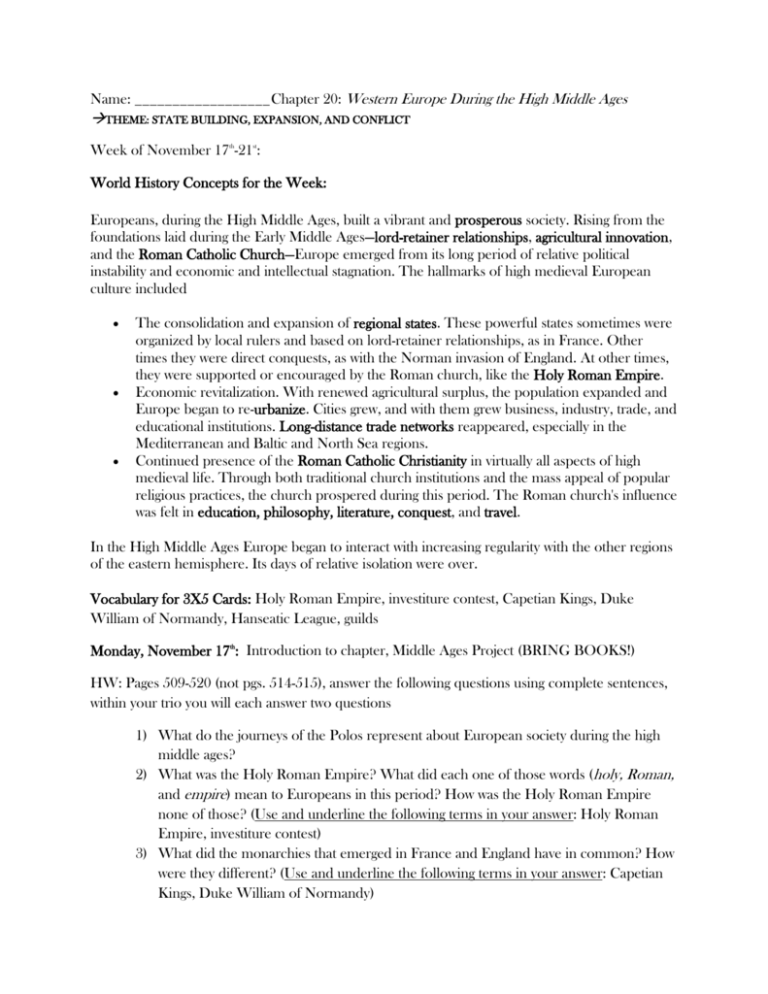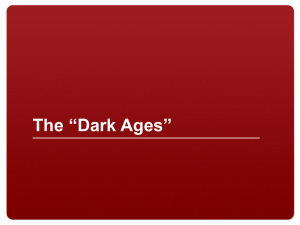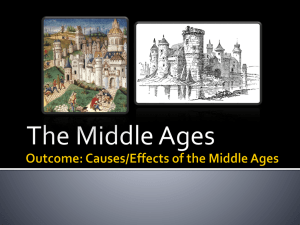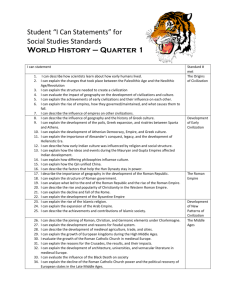Chapter 20 Guide
advertisement

Name: __________________ Chapter 20: Western Europe During the High Middle Ages THEME: STATE BUILDING, EXPANSION, AND CONFLICT Week of November 17th-21st: World History Concepts for the Week: Europeans, during the High Middle Ages, built a vibrant and prosperous society. Rising from the foundations laid during the Early Middle Ages—lord-retainer relationships, agricultural innovation, and the Roman Catholic Church—Europe emerged from its long period of relative political instability and economic and intellectual stagnation. The hallmarks of high medieval European culture included The consolidation and expansion of regional states. These powerful states sometimes were organized by local rulers and based on lord-retainer relationships, as in France. Other times they were direct conquests, as with the Norman invasion of England. At other times, they were supported or encouraged by the Roman church, like the Holy Roman Empire. Economic revitalization. With renewed agricultural surplus, the population expanded and Europe began to re-urbanize. Cities grew, and with them grew business, industry, trade, and educational institutions. Long-distance trade networks reappeared, especially in the Mediterranean and Baltic and North Sea regions. Continued presence of the Roman Catholic Christianity in virtually all aspects of high medieval life. Through both traditional church institutions and the mass appeal of popular religious practices, the church prospered during this period. The Roman church's influence was felt in education, philosophy, literature, conquest, and travel. In the High Middle Ages Europe began to interact with increasing regularity with the other regions of the eastern hemisphere. Its days of relative isolation were over. Vocabulary for 3X5 Cards: Holy Roman Empire, investiture contest, Capetian Kings, Duke William of Normandy, Hanseatic League, guilds Monday, November 17th: Introduction to chapter, Middle Ages Project (BRING BOOKS!) HW: Pages 509-520 (not pgs. 514-515), answer the following questions using complete sentences, within your trio you will each answer two questions 1) What do the journeys of the Polos represent about European society during the high middle ages? 2) What was the Holy Roman Empire? What did each one of those words (holy, Roman, and empire) mean to Europeans in this period? How was the Holy Roman Empire none of those? (Use and underline the following terms in your answer: Holy Roman Empire, investiture contest) 3) What did the monarchies that emerged in France and England have in common? How were they different? (Use and underline the following terms in your answer: Capetian Kings, Duke William of Normandy) 4) What were the significant innovations in agriculture in Europe during this period? How did each one lead to increased yield? 5) What was the role of the textile industry in the European economy during this period? 6) What were the centers of the trade networks for Europe? Why there? (Use and underline the following terms in your answer: Hanseatic League) Tuesday, November 18th: Working on Middle Ages Project HW: Pages 520-529 (each member of your trio answers one) 7) How did the development of chivalry affect the noble classes? 8) During this period Europe saw the emergence of a new social class in the cities. Who were they? What roles did they play? How did they make a place for themselves in the medieval social order? (Use and underline the following terms in your answer: guilds) 9) What is scholasticism and what broader intellectual movements did it reflect? How did it contrast with popular religion? Wednesday, November 19th (periods 3 and 5), Thursday, November 20th (period 4): Finalizing Posters HW: Pgs. 529-534each member of the trio will pick one section to answer the question for (note that you will be turning in all of your homework on Friday, * the answer you wish me to look over, notecards will be checked on that day as well) 10) Where and how did Europe expand during the High Middle Ages? a. Pgs. 529-531: “Atlantic and Baltic Colonization” b. Pgs. 531-532: “Reconquest of Sicily and Spain” c. Pgs. 532-534: The Crusades Friday, November 21st: Displaying Posters, Gallery WalkMultiple Choice Quiz (over both chapters 19-20)









